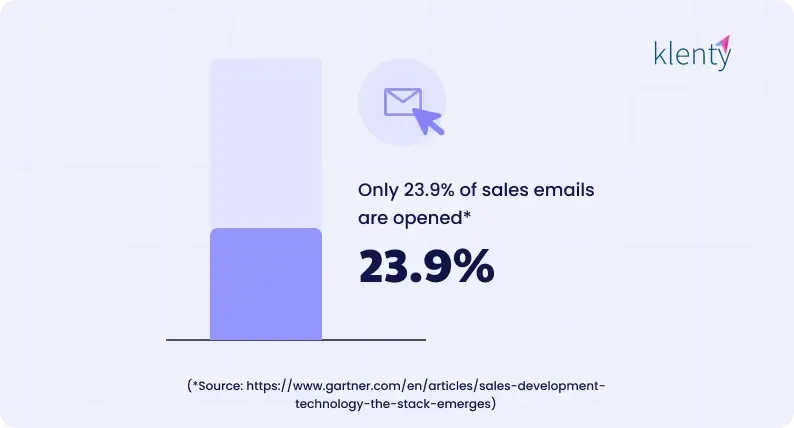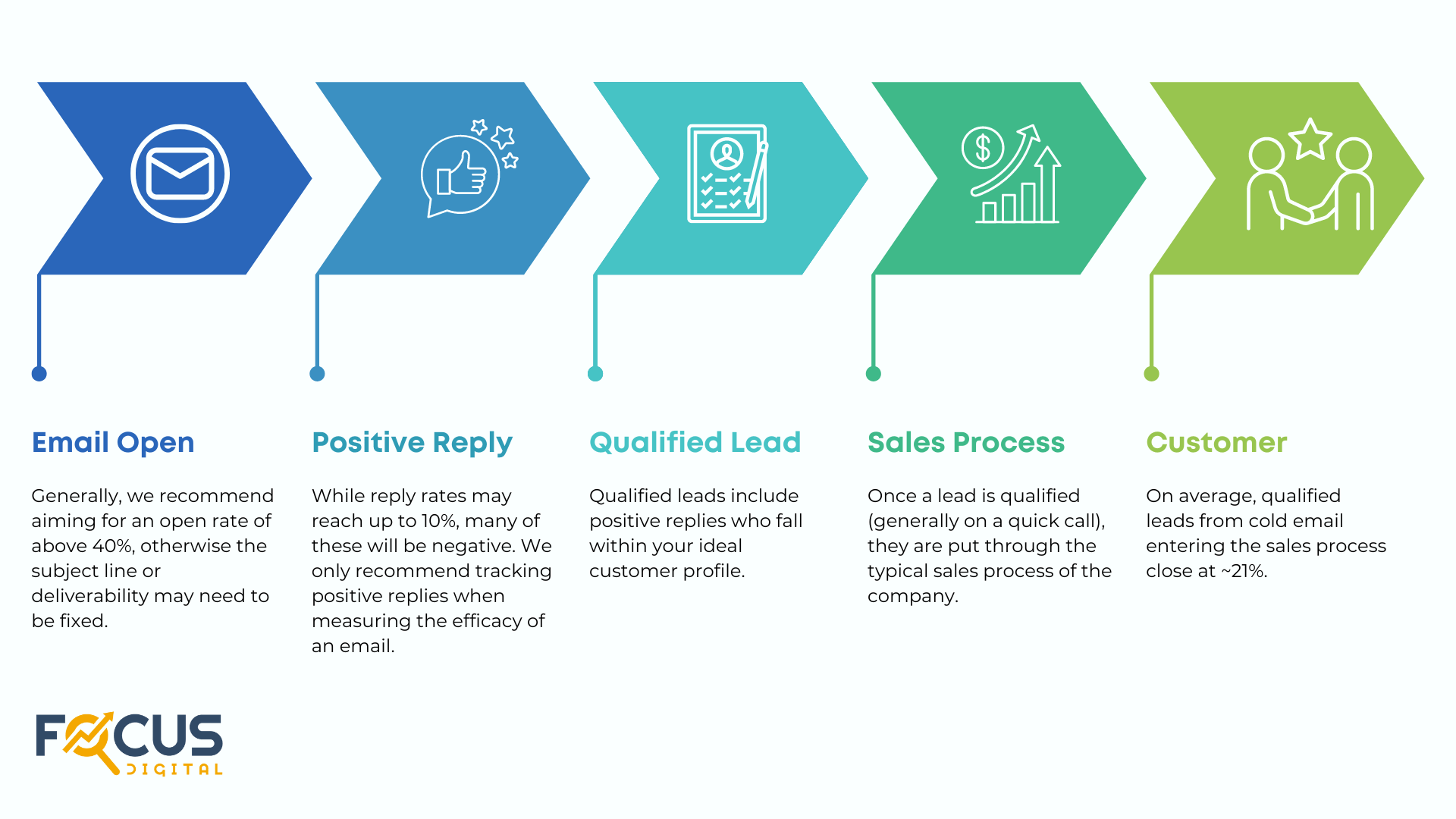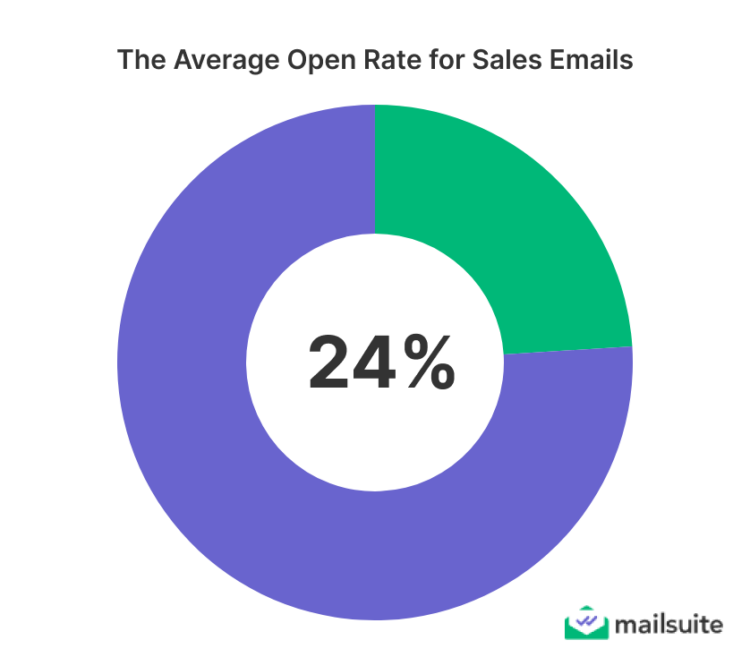The average open rate of cold-sales emails is around 15-25%. This rate varies by industry and email strategy.
Understanding these numbers can help improve your cold email campaigns. Cold-sales emails are tricky. You reach out to people who don’t know you. So, getting them to open your email can be challenging. Knowing the average open rate helps set realistic goals.
It also lets you measure your success against others in your field. This blog will dive into the factors that affect open rates. We’ll explore tips to improve your email strategy. By the end, you’ll have a clear picture of what to expect and how to do better. Let’s get started.
Introduction To Cold-sales Emails
Cold-sales emails are a common tool for reaching new potential customers. They involve sending unsolicited emails to prospects who have no prior relationship with the sender. The goal is to spark interest and initiate a conversation that could lead to a sale.
Cold-sales emails can be highly effective if done correctly. They offer a direct way to introduce your product or service to a wide audience. However, their success largely depends on the open rate of these emails.
Importance Of Open Rates
The open rate of cold-sales emails is crucial. It measures the percentage of recipients who open your email. A high open rate indicates that your subject line and preview text are compelling.
Open rates are essential because they are the first step to engaging your audience. Without a good open rate, your message won’t reach your intended audience. It means your efforts in crafting the email content go to waste.
Challenges In Cold-sales Emails
Cold-sales emails face unique challenges. One of the biggest is getting past spam filters. Many email service providers have strict filters that can flag your email as spam.
Another challenge is capturing the recipient’s attention. People receive countless emails daily. Standing out in a crowded inbox is difficult. Your subject line and the first few lines of your email must be captivating.
Additionally, personalization can be tough with cold-sales emails. Recipients are more likely to engage with emails that feel personal. However, personalizing each email can be time-consuming.
Industry Benchmarks
Industry Benchmarks for cold-sales emails are important for businesses. They provide insights into what to expect from email campaigns. Understanding these benchmarks helps in setting realistic goals and improving strategies.
Average Open Rate Statistics
On average, the open rate for cold-sales emails ranges between 15% and 25%. This means, out of 100 emails sent, about 15 to 25 are opened. These numbers give a general idea of email performance.
Variations By Industry
Open rates can vary greatly by industry. Some industries have higher open rates, while others are lower. Here is a table showing the average open rates for different industries:
| Industry | Average Open Rate |
|---|---|
| Technology | 20% |
| Healthcare | 25% |
| Finance | 18% |
| Education | 22% |
| Retail | 15% |
These numbers show that the technology and healthcare industries tend to have higher open rates. In contrast, retail has a lower average open rate. Knowing these variations helps in tailoring your email strategies.
Factors Affecting Open Rates
Understanding the factors that influence the open rates of cold-sales emails can help improve your email marketing strategy. Several elements contribute to whether a recipient opens your email or not. Let’s delve into the most significant factors.
Subject Line Impact
The subject line is the first thing recipients see. It greatly influences their decision to open the email. A compelling subject line can make a huge difference. It must be clear, concise, and intriguing.
Consider the following tips for creating effective subject lines:
- Keep it short and to the point (under 50 characters).
- Use action-oriented language.
- Avoid spammy words like “Free” or “Urgent”.
- Include numbers or lists, if relevant.
Here’s an example of a good subject line: “5 Tips to Boost Your Sales Today”
Personalization Techniques
Personalization plays a crucial role in increasing open rates. Tailoring the email to the recipient makes it feel more relevant and engaging.
Effective personalization techniques include:
- Using the recipient’s name in the subject line or email body.
- Referencing the recipient’s company or industry.
- Customizing content based on the recipient’s previous interactions.
- Segmenting your email list to target specific groups.
For example, a personalized subject line could be: “John, see how you can double your leads”
| Factor | Impact on Open Rates |
|---|---|
| Subject Line | High |
| Personalization | Medium |

Credit: www.klenty.com
Best Practices
Understanding the best practices for improving the average open rate of cold-sales emails can make a huge difference. Implementing these practices can turn a simple email into a powerful tool. Let’s dive into some key strategies.
Crafting Compelling Subject Lines
The subject line is the first thing your recipient sees. It determines whether they open the email or not. Here are some tips:
- Keep it short and to the point.
- Use action words to create urgency.
- Personalize it with the recipient’s name.
- Avoid using all caps or too many exclamation points.
Examples of effective subject lines include:
- “John, quick question about your business”
- “Last chance to save 20% on our service”
Timing And Frequency
Sending emails at the right time can increase open rates. Timing and frequency are crucial. Here’s what works best:
| Day | Best Time |
|---|---|
| Monday | 8 AM to 10 AM |
| Tuesday | 2 PM to 4 PM |
| Wednesday | 10 AM to 12 PM |
| Thursday | 3 PM to 5 PM |
| Friday | 1 PM to 3 PM |
Sending too many emails can be annoying. Aim for:
- No more than two emails per week.
- Regular follow-ups every few weeks.
These practices can help you achieve higher open rates for your cold-sales emails.
Case Studies
Case studies can help us understand the average open rate of cold-sales emails. They show what works and what doesn’t. By analyzing successful campaigns and the lessons learned, we can improve our strategies.
Successful Campaigns
One company saw a 40% open rate with a simple approach. They used personalized subject lines and kept their emails short. Another campaign achieved a 50% open rate by targeting a specific audience. They focused on solving a common problem for that group.
Some campaigns included social proof in their emails. Mentioning satisfied customers boosted their open rates. Others used curiosity in their subject lines. This made recipients want to know more.
Lessons Learned
Personalization is key. Adding the recipient’s name can make a big difference. Short emails work better. People are busy and don’t have time for long messages.
Targeting the right audience is crucial. Research your recipients and tailor your message to their needs. Testing different subject lines can also help. See what works best and adjust your strategy.
Finally, use social proof and curiosity. Show that others trust you. Make your subject line interesting. This will increase your open rates.

Credit: focus-digital.co
Tools And Technologies
Understanding the tools and technologies behind cold-sales emails can boost your success. These tools help you track, automate, and manage your emails efficiently. They can also provide insights into the effectiveness of your campaigns. By leveraging these tools, you can improve your average open rate.
Email Tracking Software
Email tracking software allows you to monitor your email’s performance. It shows you who opened your emails and when. This information helps you understand your audience’s behavior. With these insights, you can adjust your strategies to increase engagement. Popular email tracking tools include Mailtrack, Yesware, and HubSpot Sales.
Automation Platforms
Automation platforms simplify sending cold-sales emails. They save you time and effort. These platforms allow you to set up email sequences and follow-ups automatically. This ensures your emails reach the right people at the right time. Examples of automation platforms are Mailchimp, ActiveCampaign, and Drip.
Common Mistakes
Understanding the average open rate of cold-sales emails is crucial for any marketer. Yet, many make common mistakes that significantly reduce their open rates. Recognizing and avoiding these pitfalls can lead to more successful email campaigns. One such mistake is crafting a lackluster subject line that fails to capture attention. Additionally, using coldhearted email closing examples can leave a negative impression, making recipients less likely to re-engage in future communications. By refining these elements, marketers can ensure their emails are not only opened but also elicit a positive response.
Spammy Content
One of the biggest mistakes is including spammy content in your emails. This can trigger spam filters and prevent your emails from reaching the inbox. Here are some examples:
- Using too many exclamation marks and ALL CAPS.
- Inserting too many links or images.
- Using over-the-top sales language like “once in a lifetime offer” or “act now”.
Ensure your emails are clear, concise, and to the point. Focus on delivering value to the recipient.
Ignoring Analytics
Many marketers ignore email analytics. This is a costly mistake. Analytics provide insights into what works and what doesn’t. Key metrics to monitor include:
| Metric | Importance |
|---|---|
| Open Rate | Shows the percentage of recipients who open your email. |
| Click-Through Rate | Indicates the percentage of recipients who clicked on a link in your email. |
| Bounce Rate | Shows the percentage of emails that could not be delivered. |
By analyzing these metrics, you can refine your strategy. This will help you create more effective cold-sales emails.

Credit: mailsuite.com
Future Trends
Understanding the future trends of cold-sales email open rates can help businesses prepare better strategies. As technology advances and consumer behaviors shift, predicting these trends becomes essential for staying competitive.
Ai And Machine Learning
AI and machine learning play a significant role in the future of cold-sales emails. These technologies can analyze large datasets to identify patterns and predict outcomes. By using AI, businesses can:
- Personalize email content more effectively
- Optimize sending times for higher open rates
- Analyze recipient behavior to improve targeting
Personalized content increases the chances of engagement. Optimized sending times ensure emails reach recipients at the most suitable moments. AI can also predict which subjects and content formats work best.
Evolving Consumer Behavior
As consumer behavior evolves, so does the effectiveness of cold-sales emails. Consumers now prefer emails that are:
- Relevant to their interests
- Concise and to the point
- Visually appealing with minimal text
To adapt, businesses need to:
- Use segmentation to target specific groups
- Create visually appealing templates
- Craft short, engaging subject lines
Understanding these preferences allows businesses to create emails that recipients are more likely to open.
Frequently Asked Questions
What Is A Good Open Rate For Cold Emails?
A good open rate for cold emails is typically around 15% to 25%. This rate can vary by industry and target audience.
How Can I Improve My Cold Email Open Rate?
To improve your cold email open rate, personalize your emails, use compelling subject lines, and ensure your sender name is recognizable.
Why Do Cold Emails Have Low Open Rates?
Cold emails often have low open rates because recipients don’t recognize the sender or find the content irrelevant.
What Factors Affect Cold Email Open Rates?
Several factors affect cold email open rates, including subject lines, sender reputation, email content, and timing of the email.
Conclusion
Understanding the average open rate of cold-sales emails helps improve strategies. Aim for clear, engaging subject lines. Personalize content to boost engagement. Test different approaches and analyze results regularly. Keep emails short and to the point. Follow these tips and improve your email open rates.
Remember, persistence and adaptation are key. Stay consistent and keep refining your methods. Success in cold-sales emails comes with practice and patience.
